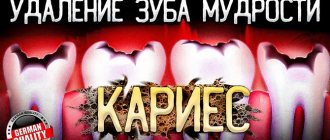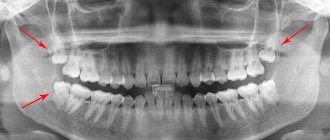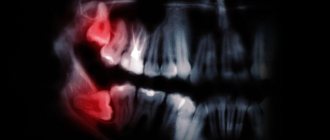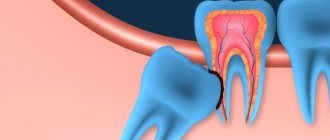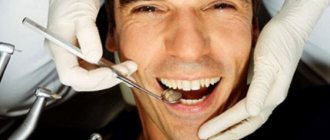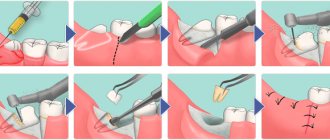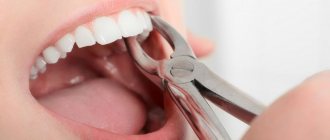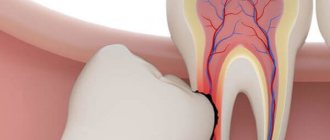Wisdom teeth, also called figure eights, often contribute to the development of dental defects. Therefore, sometimes situations arise when it is necessary to remove them. But such a procedure is quite traumatic. Before a specialist approves the removal of wisdom teeth, he weighs all the pros and cons and only then makes a final decision.
The condition of each patient’s wisdom teeth is carefully examined by the doctor, and a decision is made in each individual case only on an individual basis. indications.
How to prepare your teeth for braces
- First of all, an external examination of the dentition, face and oral cavity is performed.
- In addition to the teeth, the condition of soft tissues is examined and assessed.
- Diagnosis is made using orthopantomography and visual examination.
- X-ray photographs of the jaws are studied.
After which the doctor decides what treatment measures should precede the installation of braces. Based on the state of the dentition, teeth for installing braces are divided into three groups:
- Group A, in which high-quality dental treatment and plastic surgery to reduce the frenulum are performed;
- Group B – carry out measures to preserve teeth;
- Group C – minimal manipulations are performed that do not create risky complications.
Is it possible to install braces without removing them?
Correcting a bite with a braces system comes down to moving the teeth in the right direction. If staples are installed without removing interfering elements, then orthopedic treatment will not bring the desired effect. For some types of pathology, structural features of the dental system and in childhood, extraction is not required.
An alternative to surgery is separation. It involves removing a layer of enamel from the side surfaces of the crowns. This way the required free space is achieved. The procedure is minimally invasive, does not require a recovery period, and does not cause pain or discomfort. The advisability of using this method should be discussed with your doctor.
Is it worth removing teeth before installing braces?
Doctors believe that figure eights should be removed in several cases:
- If the size of the tooth does not match the size of the jaw. These are usually very large teeth;
- When protruding teeth in the upper jaw row, when the jaw is highly developed, the teeth must be removed;
- With the lower jaw retracted, wisdom teeth are removed to give the face a normal oval.
When is it necessary to remove teeth before braces?
Sometimes there really is no alternative to deletion. Moreover, it is not the third molars that have to be removed, but completely different teeth.
Sometimes patients come for a consultation with an orthodontist with straight teeth, but a so-called “convex profile” that prevents them from even closing their lips. In such cases, the removal of “fours” and/or “fives”, first and second premolars helps to correct the situation with both appearance and bite. Removal is performed in pairs - according to indications, in one or both jaws.
Do I need to remove wisdom teeth before braces?
There are some cases where orthodontists remove full teeth. But correction alternatives can often be used:
- It is often recommended to remove teeth if they are too large or the jaw is not large enough. Such an anomaly is demonstrated as crowded teeth or protrusion (they lean too far forward). This is all determined thanks to a teleroentgenogram. But most often the reason for removal is a deformation of the jaw when it is smaller than necessary. Here we look at options on how to get the right amount of free space and at the same time save your teeth.
- Teeth are not always removed in case of upper prognathia (the upper jaw moves forward). If it is excessive in size, then most likely the teeth will have to be removed. If the jaw is of normal size, then protrusion may be caused by problems associated with the cervical spine. Here you need to contact an osteopath.
- The anomaly may develop due to the fact that the jaw moves back. Will wisdom teeth need to be removed? In most cases, experts recommend removing such teeth if the aesthetic appearance of the human profile is compromised. Normal jaw sizes do not imply any disturbance in appearance. If the sizes are too small or large, then the patient requires serious surgical intervention, and not simple tooth extraction.
What is separation?
An alternative to removing figure eights before installing braces is the separation procedure. This method is considered more gentle and physiological for the patient. Its essence is that a thin layer of enamel is removed from the side surface of one or more teeth. This allows you to free up space in your jaw without having to remove teeth. During separation, the dentist removes approximately an enamel layer only 0.25 mm thick, which does not affect the health of the tooth, but can lead to increased sensitivity.
Separation is a relatively simple and painless procedure. Sometimes only 0.2-0.5 mm is missing to turn the tooth, and in this case, removing the enamel layer helps solve the problem. If, for such indications, the tooth is completely removed, more space will be freed up than necessary.
The advantages of separation are obvious:
- after the procedure there is no hole left that needs to be properly cared for;
- there is no risk of complications, infection of the wound, pain, as after tooth extraction;
- The procedure is performed quickly, does not require preparation, and does not cause discomfort to the patient.
Separation is carried out in different ways. The first option is to use thin abrasive strips, or strips. First, the dentist grinds the teeth with them, and then grinds the surface until smooth. Another method is separation using special wedges, which are installed between the teeth for 24 hours and free up the space necessary for the orthodontist.
Since the procedure increases the sensitivity of the enamel, the doctor will recommend remedies to reduce it.
Why are wisdom teeth removed before braces?
There are certain points about wisdom teeth that you need to know:
- when teenagers are about to undergo orthodontic treatment and I take a panoramic photograph, the rudiments of these teeth are clearly visible;
- Beginning wisdom teeth do not have roots, they are located under the bone, its thick layer. This layer is also called the bony visor;
- A teenager’s body is at a growth stage, so it can react sharply to surgery. After all, initially this manipulation involves cutting soft tissues, and then removing the bone, which is located above the 3rd molar, extracting the tooth;
- After surgery, tissue swelling occurs. If we are talking about a child, then as a result it will be difficult for him to open his mouth, and the temperature often rises.
The doctor cannot predict whether wisdom teeth will be problematic in the future. Therefore, in most cases, before correction in adolescents, they are not often removed so as not to injure the child.
After a while, the eights will have a root system and then they can already bother the patient. According to the orthopantomogram, those wisdom teeth that have not erupted are defective. Often such teeth are located horizontally in the jawbone and then they can significantly harm the sevens that are in front. After all, this provokes resorption of the bone septum between the teeth, destruction of the ligamentous apparatus that holds all the teeth in the bone. Do these wisdom teeth need to be removed? In such situations, it is necessary to remove the wisdom teeth, even if the specialist does not then install braces.
If a wisdom tooth that has not fully erupted or has not erupted at all is left in the same position and braces are installed, this can cause the teeth to move outward. 1-2 nights will be enough for the teeth to move. Here the orthodontic arch will not be able to resist, and the money spent on braces will simply be wasted.
Our body is designed so amazingly that there is nothing superfluous in it. Everything appears and manifests itself in due time, and fulfills its clear function. So a person needs wisdom teeth. Only now it is no longer for modern man, but for ancient man. As we know, the main function of large molars - molars - is to grind and grind food to form a food bolus and better digestion in the next stages of digestion. Our ancestors lived in wild conditions, eating tough parts of plants, unprocessed meat, and other solid foods. Nobody thought about cooking delicacies back then. As well as about dental treatment, although there were prerequisites. There was also nothing to clean teeth with, although ancient people chewed tree resin and beeswax. People began to seriously think about how important it is to brush their teeth and maintain oral hygiene only in the 4th-5th centuries. BC. How long can a tooth last under such unforgiving conditions? Much less than today. This is why ancient man needed a wisdom tooth, so that the chewing process could be carried out efficiently, even if one of the molars collapsed and fell out. Just the full formation and eruption of the wisdom tooth occurred at the time of the loss of one of the molars.
What happened now that wisdom teeth, seemingly so wisely and carefully invented by nature, have become a “headache” for most people? Over time and evolutionary processes, people switched to gentle food that does not require such intense chewing. The food cooks, becomes soft and pliable, and now threatens a person’s teeth except with the formation of soft and hard plaque. With this lifestyle, the jaw has become smaller and narrower. Ideas about health care have developed. Nowadays you can find hygiene products for oral care for every taste, and you can visit the dentist to treat caries at any time. All living conditions developed in such a way that the role of the wisdom tooth began to decrease until it became completely negative.
Do modern people need wisdom teeth? Let's figure it out together.
How does a wisdom tooth appear?
The eighth teeth are exactly the same in nature as the other 28 teeth in the mouth. Their main difference is the time of germination - at 4-6 years, while the rest of the germs are laid during intrauterine development. They appear quite late, at the age of 18-25, which is why they are called wisdom teeth. It was believed that by the time the eighth teeth appeared, a person had already gained wisdom. The root of the tooth is formed even after eruption. By the time it grows, growth-forming factors in the body have already been reduced, since all other teeth have long been formed. The mucous membrane is thickened, the walls of the dental sac are dense and do not dissolve, which is why the tooth erupts with such difficulty and causes pain to the person.
Why save wisdom teeth?
It is incorrect to state unequivocally that wisdom teeth must be removed. Yes, now it seems that eights no longer perform their genetically assigned functions, do not participate in the chewing process and bring much more problems than benefits. Looking ahead, wisdom teeth can play an important role in adulthood, when the installation of a prosthesis is required, and the first and second molars either fall out or are unsuitable for serving as supporting teeth. A well-preserved eighth tooth in some cases can protect against implantation, which will greatly increase both the time and cost of treatment.
One of the new types of operations in surgical dentistry is the replantation of one tooth into the socket of another, just removed. So, you can use a healthy eight.
Even today, when medicine is aimed at prevention, it is not possible to avoid tooth loss, since periodontal diseases are very aggressive and fast-growing. With the loss of a large number of teeth, eights can partially take over the chewing functions.
Another “invisible function” that cannot be noticed is that figure eights hold teeth in the correct position. Teeth tend to move throughout life under the influence of loads (orthodontic treatment is based on this property). With a large jaw or in old age, the eighth teeth occupy free space and prevent the teeth from spreading and loosening excessively, and maintain the bite.
It happens that the patient’s body is weakened by other diseases, in which case it is not worth removing a tooth unless absolutely necessary, because surgery is always stressful for the body, requiring the immobilization of all resources. Such diseases are acute pathologies of the cardiovascular system. The removal operation is postponed for at least six months, and it is impossible to carry out it without consulting a cardiologist. If there is a tumor in the area of the eighth tooth, you should not rush to remove the tooth, as this can provoke rapid development of the tumor. Before this, the tumor is treated or removed.
Most likely, the dentist will consider the removal of the eighth teeth inappropriate if they erupted healthy, without complications, took the correct position in the dentition and their canals are well passable, and if normal conditions have been created to maintain good hygiene of these teeth.
Why remove wisdom teeth
The eighth teeth are rightfully considered the most problematic teeth in humans. They begin to cause inconvenience even when they have not yet erupted. Today they are a hindrance for orthodontists, therapists, and orthopedists. There are many problems associated with the growth process of these teeth:
- Dystopia – the tooth grows in the wrong position, in the wrong direction. Often the eighth tooth props up the roots of the seventh, which is fraught not only with inflammation and destruction of the root of the seven, but also with the movement of all teeth and the formation of crowding. When the dystopic figure eight erupts, it often injures the mucous membrane of the cheek, tongue and, if it does not have an antagonist, the mucous membrane of the gums, causing the formation of erosions and ulcers.
- Often eights are affected by caries due to their incorrect position or too close contact with the adjacent tooth. In such conditions, it is impossible to ensure high-quality home hygiene, and professional hygiene is very difficult. Wisdom teeth often have irregularly shaped, very tortuous canals, which complicates endodontic treatment. Often teeth are affected by root caries, which is very difficult to notice until the process reaches a severe stage. The carious process can spread to the roots of the seventh tooth.
- Eighth teeth often cause the formation of various cysts, granulations, and tumor-like formations, which can also affect neighboring teeth.
- Pain during eruption is due to the fact that the wisdom tooth does not have a predecessor and the process of eruption occurs quite late, in the place where the mucous membrane has become very thick. Often, gum eruption is accompanied by a rise in temperature and a deterioration in mood. The appearance of a tooth is complicated by the formation of an inflamed gum hood, which can only be removed by a dental surgeon.
- Wisdom teeth are the sworn enemies of orthodontists, because if the bite has been corrected and the teeth are aligned, and the eights are not removed, then when they begin to grow, especially if incorrectly, the teeth will become crooked under pressure and no retainer will be able to hold them.
- Even an unerupted tooth can cause problems. It damages the roots of large molars and is a source of neuralgic pain.
At the consultation, after examining the x-ray, the doctor will be able to determine whether the eighth tooth will cause problems in the future, and will try to prevent them.
Operation process
The operation usually does not take much time, especially on the upper jaw, since the roots of the upper eights are most often of the correct shape. Bottom eights can be quite tricky and take longer to remove. The operation begins in the standard way - with local anesthesia. When the anesthesia has taken effect, the doctor separates the tooth from the soft tissues to avoid unnecessary trauma to the gums during removal. If the tooth is impacted, access is created through an incision in the gum and, if necessary, drilled out of the bone. Using an elevator, the doctor dislocates and removes the tooth from its socket. If the tooth has bent roots, it may need to be divided into fragments and extracted in parts. Afterwards, the hole is inspected for foreign bodies and cleaned. If there was an incision, it is sutured, and stitches are applied if necessary. A few days later the patient comes for a follow-up examination.
Oral care after surgery
Tooth extraction is always an injury to the mucous membrane, even if the operation was successful and without complications. After the anesthesia wears off, the patient may feel mild, spontaneous pain, which is normal. The pain disappears 2-3 days after the intervention. After surgery, the main task becomes to preserve the blood clot in the socket of the extracted tooth or to provide rest to the damaged soft tissues if suturing was performed. Under no circumstances should you test the removal site with your tongue; it is better to just forget about it and go about your business. It is imperative to brush your teeth, as the oral cavity must be kept clean to avoid infection of the wound. Cleaning is carried out carefully, without sudden movements, using a brush with soft bristles and avoiding the removal site. In the first 3-4 hours, it is better to stop smoking or drinking through a straw (many patients mistakenly believe that after removal they need to drink through a straw so as not to touch the removal site), since this creates a vacuum, due to which the clot can be pulled out of holes and then alveolitis cannot be avoided. On the day of removal, you should avoid too hot food, drinks, thermal procedures, heavy sports, alcohol, in general, anything that can cause sudden changes in pressure. Your doctor will tell you in more detail whether it is worth rinsing the extraction site and how to do it.
Myths associated with wisdom teeth
Now, finally, it remains to dispel a few myths associated with wisdom teeth.
Myth 1 . Everyone has wisdom teeth. It may seem so because almost 90% of people have a full set of eighth tooth buds. But there are also people who have three or fewer wisdom teeth. 10% do not have eights at all, it would seem that this is not so small. Wisdom teeth are a rudiment that has now lost its main role. It can be assumed that after many millennia, wisdom teeth will disappear altogether, and their appearance will be considered an anomaly.
Myth 2. Wisdom teeth must be removed. Some doctors are convinced that figure eights must be removed, the sooner the better. In fact, if there are no indications for removal, the tooth develops correctly and does not disturb already formed teeth, as well as soft tissues, then there is no need to remove it. Who knows, maybe a wisdom tooth will be needed in adulthood, when the patient needs prosthetics.
Myth 3 . Any discomfort during the eruption of wisdom teeth is normal, you just need to endure it. You should never endure discomfort, and this case is no exception. It is better to consult a doctor who will alleviate the condition and identify pathologies at an early stage, when they can still be eliminated without consequences.
Myth 4. Removing wisdom teeth is always scary, painful and time-consuming. It's not like that at all! You just need to find your doctor whom you can trust completely. If the tooth is positioned correctly and there are no additional pathologies, then the operation time does not exceed 30 minutes. If the tooth is complex, it will take more time, but the patient will still feel calm and comfortable in the chair, thanks to the skillful hands of the doctor.
Where to begin?
The first step on the path to a healthy smile is always a consultation with a dentist. After studying the clinical situation and the patient’s complaints, the doctor determines whether it is advisable to remove wisdom teeth. Additional x-ray examination is often required to determine the condition of the roots and peri-radicular bone. The cost of the operation depends on the degree of its complexity. Current prices can be found on the website in the appropriate section, as well as by calling the specified phone number. By following your doctor's recommendations, you can maintain oral health for years to come.
Features of orthodontic treatment after tooth extraction or loss
If a side tooth is lost, the problem is solved in one of two main ways:
- prosthetics - replacing a lost tooth with an artificial one;
- closing the resulting space by displacing the remaining teeth (performed using a brace system).
Of course, orthodontic movement to the site of an extracted tooth is extremely rarely practiced independently. Often, this approach allows you to solve several problems at once - aligning the dentition, normalizing the bite.
Will my appearance change after molar removal?
To maintain facial symmetry, third molars are removed in pairs - simultaneously on the lower and upper jaws, or in fours at once. If wisdom teeth remain on one side, the line of closure of the upper and lower teeth may become skewed, and the smile will become asymmetrical.
In most cases, removal does not lead to noticeable changes in appearance. But, for example, in patients with small facial features due to a certain structure of the jaw, changing its internal structure can cause undesirable consequences. The face will look noticeably thinner, the cheeks will appear sunken, and the cheekbones will appear more defined. In such cases, before removal, you should consult several dental clinics, and perhaps seek advice from a plastic surgeon. If the changes turn out to be critical and undesirable, instead of removal, another method will be chosen to free up space on the jawbone.
What happens if are not removed getting braces The mechanical effect of the orthodontic arch on the dentition will force crooked teeth to straighten, but since there will be no more space on the jaw by the time the structure is removed, over time they will take their previous positions.
Quick appointment Free consultation
Removal for asymmetry of dentition
Asymmetry occurs for several reasons:
- premature removal or loss of milk teeth - eruption of permanent teeth “out of place”;
- asymmetrical removal of permanent teeth - in this case, the remaining teeth are displaced due to the resulting free space.
The result of tooth displacement is a violation of the midline - the line of contact of the two central incisors. It should correspond to the midline of the face or the center of the lip. A displacement of more than 3 mm is noticeable not only to a professional, but also to an ordinary person. This situation requires the removal of a tooth on the side opposite to the direction of displacement.
